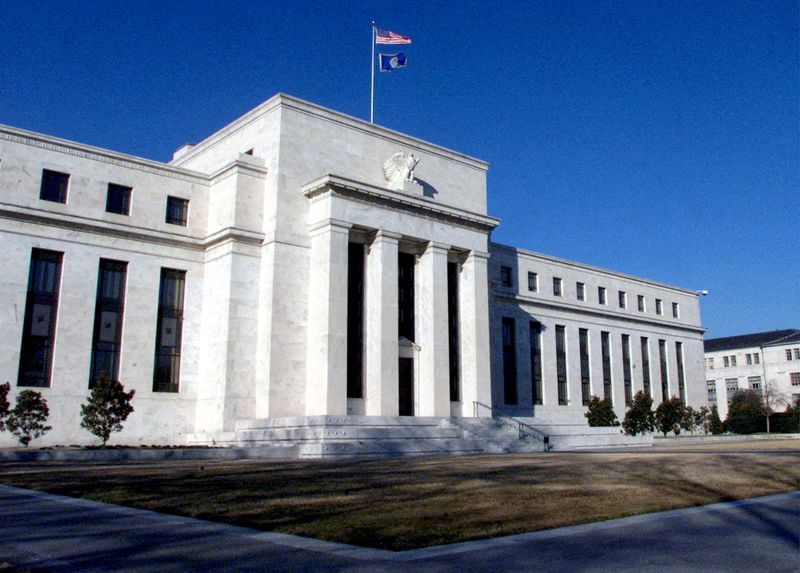By Michael S. Derby
NEW YORK (Reuters) - Almost half a year after Silicon Valley Bank went belly up and nearly set off a national banking crisis, still-growing borrowing from a Federal Reserve emergency lending facility gives the appearance of lingering trouble for the financial sector.
But while the ongoing demand for the Fed's Bank Term Funding Program may result from some overhang from the initial troubles back in March, the growth in its loan output this summer more likely arises from opportunistic money management strategies some banks may be employing.
Usage of the BTFP rocketed at launch, shooting from nothing at the start of March to $79 billion a month later. From early May onward, though, it has taken on another $32 billion, albeit at a much more plodding pace. BTFP loans stood at $108 billion on Wednesday.
So far, there is no sense the increase signals a return to bank stress. Instead, borrowing via the program mostly represents longer-term loans taken out at its onset, likely by a limited number of institutions, coupled with some recent additional borrowing from banks who saw economic value in doing so.
“Most of the borrowing was done by the troubled banks at the beginning” and when it comes to the modest amount of growth seen over the summer, “I don’t think of this as an indication of trouble,” said Joseph Abate, strategist with investment bank Barclays.
The Fed launched the BTFP in March. It did so to help calm the financial sector and support banks in the wake of several high-profile failures that rattled the global economy in a time of high inflation and aggressive Fed rate hikes aimed at quelling those price pressures.
Compared to other forms of Fed emergency lending, the terms of the loans are generous. The Fed said it would offer credit at 10 basis points over wherever the one-year overnight index swap rate stood at the time of the loan. The Fed also said it would take as collateral any securities it buys for monetary policy operations at face value, rather than at a discount.
A look at how other Fed emergency lending programs have fared backs up the idea BTFP borrowing is happening for reasons other than stress.
Fed discount window lending, the central bank's main tool to offer short-term liquidity to banks, rocketed up in the spring and hit a peak of $153 billion on March 15 before rapidly falling as the much-worried-over banking crisis never developed. As of Wednesday, these loans totaled $2.9 billion, a fraction of their peak in March and the lowest in a year or more.
EASY MONEY
Market conditions may also explain why some banks have found some room to tap the BTFP even as overall conditions in their industry have returned to normal. That’s because they can get a favorable treatment for bonds that have lost value due to the surge in yields seen over recent weeks.
“The treatment of collateral at par is unusual; the higher yields rise, the greater the implicit subsidy for bonds trading below par,” LH Meyer analyst Derek Tang wrote to clients in a research note last week. Tang also noted data pointing to the duration of the loans taken via the BTFP indicates some banks have been interested in locking down funding rather than possibly having to tap the discount window at an interest rate they can’t predict right now.
What’s more, the difference between the rate offered on the BTFP and the central bank’s interest rate target, the federal funds rate, has grown tighter since the late July rate hike, whereas before that, the BTFP rate had been for a number of weeks notably higher, which had degraded some of its attractiveness as a source of liquidity. On Friday the BTFP rate stood at 5.45%, within the federal funds target rate range of between 5.25% and 5.5%. It was also just under the 5.5% discount rate.
The BTFP is scheduled to shut down next March and there's no sense the Fed is fixing to extend its life. And thus far, demand has also been a niche concern.
Fed data released in May showed that among participants in its Senior Loan Officer Survey only 15.2% of 92 respondents said they’d tapped the program.

One sign of why some may have avoided BTFP loans? A majority of respondents said the eventual reveal of who borrowed from the program was a negative for them. The Fed will disclose this information one year after the program ends.
That echoes a long-running problem the Fed has faced with emergency lending: The perception that tapping central bank liquidity will stigmatize the borrower among other financial institutions that did not need to turn to the Fed for cash.